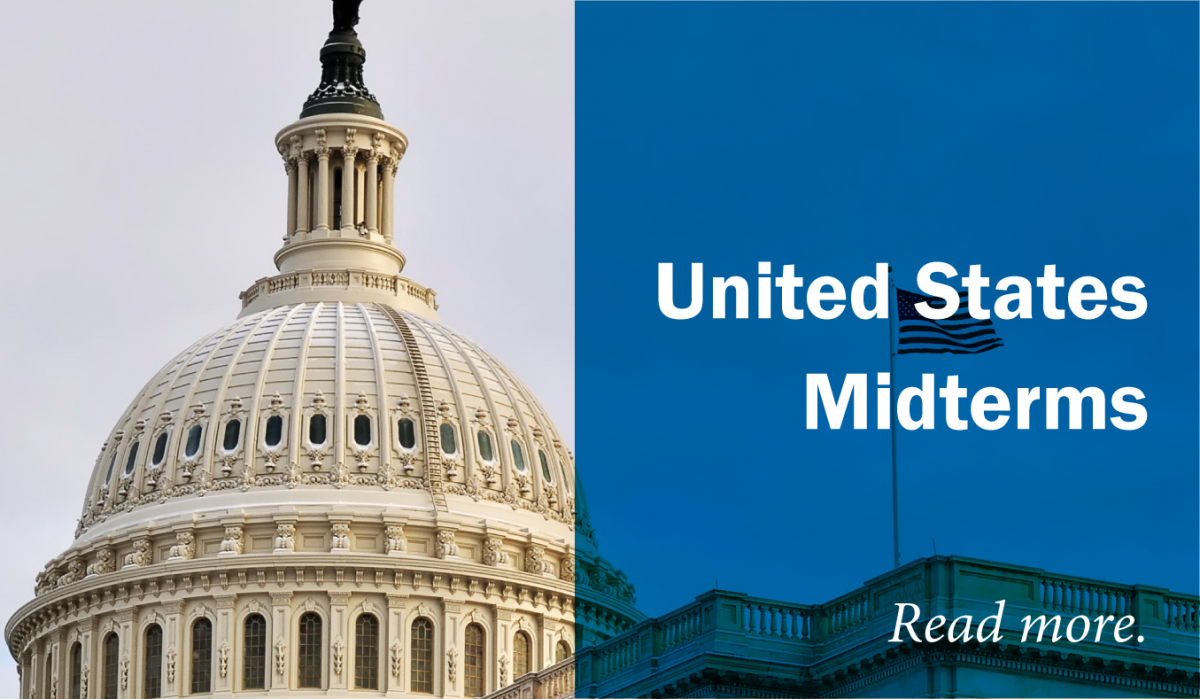Key Numbers and Races
"A wave of veteran candidates are running and a number of leadership positions will change." –Reta Jo Lewis
As we approach the final weeks until the 2018 midterm elections, the stakes are high for both the Republican and Democratic parties as they look toward the 116th Congress. Historically speaking, Congressional midterm elections in the United States are often defined by low voter turnouts and a loss of seats for the sitting president’s party. A study by Brookings shows that the last 21 midterm elections have seen the president’s party average a loss of 30 seats in the House of Representatives and 4 seats in the U.S. Senate, especially when the president has an approval rating below 50 percent. As such, the midterm elections are seen by some as a referendum on the president’s party and a moment for significant gains by the minority party. President Trump’s approval ratings since taking office have remained near 40-45 percent, indicating that the Republicans majorities are in real danger. Furthermore, a September 2018 Pew poll of registered Democrats found that 67 percent of respondents felt renewed enthusiasm about voting for their party as opposed to 36 percent in 2008. Even after the fight over Brett Kavanaugh’s Supreme Court confirmation gave the Republicans a bump in support, many analysts agree this did not significantly reduce support for Democrats.
This year’s election features 35 Senate seats, currently with 26 held by a Democrat and 9 by a Republican. Of those 35 seats, control of the Senate will hinge on the outcome of 9 toss-up races in which the candidates are virtually tied. President Trump carried five of these states in the 2016 election, so with the races still too close to call the environment seems more favorable for Republicans. In fact, recent polling data from FiveThirtyEight shows Democrats with only a 20 percent chance of taking control of the Senate.
Female voters and candidates are a big story in this election. Record numbers of female candidates are running (see section on Republican Women). People are also watching for female and young voter turnout. Youth voter advocates hope that the power of nationwide grassroots movements, such as those aimed at reducing gun violence, could mobilize youth voters, whose midterm election turnout is historically around 20 percent. But this time around a recent PEW poll shows 62 percent of millennials, aged 22 to 38, are “looking forward” to voting.
Another interesting feature of the midterms is the wave of military veterans and former national security officials running for Congress, many of them running as Democrats. If elected in significant numbers, this group could become very influential in helping to forge U.S. defense, diplomacy, and development policy for years to come. These new leaders could strongly influence transatlantic affairs, particularly by ensuring security cooperation through the Congress, similar to what we have seen with the European Deterrence Initiative (See Some Good News for NATO section).
Regardless of results, leadership roles and priorities in the Senate will shift after the election.
Regardless of results, leadership roles and priorities in the Senate will shift after the election. The current Senate Armed Services Chairman Sen. James Inhofe (R-OK) replaced the late Sen. John McCain (R-AZ) after he stepped down to receive treatment for brain cancer. As Chairman, Sen. McCain was a frequent critic of the Trump administration and Defense Secretary James Mattis; Inhofe on the other hand is a strong supporter of President Trump and his foreign policy agenda. Senate Foreign Affairs Committee Chairman Sen. Bob Corker (R-TN) is retiring which leaves openings for new voices to shape matters of foreign policy and national security. All eyes are on Sens. Lindsey Graham (R-SC), Marco Rubio (R-FL), Richard Burr (R-NC), and James Risch (R-Idaho) to fill the foreign policy leadership vacuum left by Sens. McCain and Corker.
Democrats are, according to polls, better positioned to take the majority in the House of Representatives. A Democratic House majority would likely focus on policy issues such as protective immigration measures, a review of the defense budget, and election and cybersecurity. Immigration would be a top priority; expected legislation could focus actions to protect recipients of the immigration policy Deferred Action for Childhood Arrivals (DACA) and examine the viability of a wall at the U.S.-Mexico border. It is probable that Democrats would introduce measures to shore up U.S. election infrastructure against foreign interference (see Foreign Threats to Elections section).
If the Democrats gain control of the House, the House Armed Services Committee chairmanship could go to Rep. Adam Smith (D-WA), a top Democrat on the committee since 2011. The House Foreign Affairs Committee Chairman Rep. Ed Royce (R-CA) is retiring and the Europe, Eurasia, and Emerging Threats Subcommittee Chairman Rep. Dana Rohrabacher (R-CA) has a difficult re-election race. Thus, two crucial foreign policy chairmanships could be available to Democrats if they capture the majority.
The election of the 116th Congress is also expected to bring about a rebalancing of House leadership. Despite some challenges coming from her own party, Rep. Nancy Pelosi (D-CA) has made it clear that she will run for Speaker of the House if Democrats take control. On the Republican side, the imminent departure of Rep. Paul Ryan (R-WI) has left leadership of the House Republicans open for competition. Shifts in leadership will naturally affect the priorities of the parties and Congress as a whole. Though our colleagues argue that major foreign policy shifts should not be expected (see Do Not Look for Foreign Policy Change section), our allies can expect a number of new faces in the Congress and in key foreign policy leadership positions.
Read the full publication »
Photo Credit: Derek Hatfield / Shutterstock

